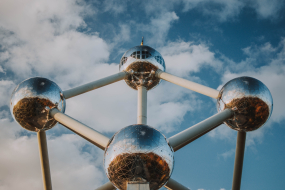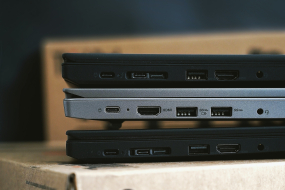Digitization can save one in five tons of CO2
- Bitkom provides comprehensive study about the climate impact of digitalization
- Digital technologies can contribute half of the emissions reductions that are necessary for Germany to achieve its climate objectives
- Digitization is most effective in reducing emissions in industrial manufacturing, mobility and energy
Berlin, 18th March 2021 - Digital technologies can contribute half of the emissions reductions that are necessary for Germany to achieve its climate objectives for 2030. The study “Climate Impacts of Digitalization”, which was carried out on behalf of Germany’s digital trade association Bitkom, shows that a targeted and accelerated implementation of digital solutions can reduce CO2-emissions in Germany by 151 megatons within the next ten years. This corresponds to one fifth of the country’s current CO2-emissions. Accounting for the emissions produced by digital devices and infrastructures, this constitutes net CO2-savings of 129 megatons. To achieve its climate objectives, Germany must reduce its emissions by 262 megatons of CO2 within the next ten years. “An accelerated transformation towards a digital economy remains the challenge of the hour, not only but also because of climate change”, states Bitkom-CEO Dr. Bernhard Rohleder.
Germany’s CO2-emissions amounted to 805 megatons in 2019 and must be reduced to 543 megatons by 2030. This translates to a lowering of per capita emissions from 9.7 tons per year to 6.6 tons per year within the next ten years. Rohleder: “We need a comprehensive and climate-oriented digital strategy. Digital technologies enable us to save enormous amounts of CO2 and increase our international competitiveness and resilience at the same time.”
The Bitkom study was carried out by Accenture’s experts on environment and digitalization. It scrutinizes seven fields of application in which digital technologies have a particularly large potential for emission-savings. Those areas include industrial manufacturing, mobility, energy, buildings, work & business, agriculture, and health. The study also investigates CO2-emissions of digital technologies caused by their production and the use of devices such as screens, computers, and tablets as well as the operation of data centers and network infrastructure. These can emit around 16 megatons of CO2 annually if the digital transformation proceeds at a moderate speed. An accelerated digitalization process could cause up to 22 megatons of CO2 emissions. The study concludes, however, that in total the potential for emission savings is six times higher than the carbon footprint of digital technologies.
According to Bitkom, the decisive factor will be the design and pace of the digital transformation until 2030. The study shows if the digitalization in Germany continues at its moderate pace, CO2-emission savings could amount to 102 megatons. This corresponds to 39% of emission saving s necessary to reach the climate objectives for 2030. Accounting for emissions from the production and use of digital technologies, the net effect would be 86 megatons or 33% of necessary emission savings. At an accelerated pace, a targeted digitalization process could significantly increase the CO2 reduction to 151 megatons, which would constitute 58% of emission savings required by the national climate objectives (net: 129 megatons CO2 or 49% of emission savings). The overview below summarizes the sector-specific findings of the study:
Energy
Emission savings of 19 megatons in the moderate digitalization scenario and 23 megatons CO2 in the accelerated digitalization scenario are possible in the energy sector. The key technology in this sector are smart grids which can precisely manage energy production and consumption. They not only enable data and energy to flow from the producer to the consumer, but also the other way round. This allows for a more optimal and efficient operation of power networks. Furthermore, digital technologies can contribute to a more efficient production of renewable energy. Artificial intelligence and Big Data can monitor and analyze renewable energy generation in real time, thus, preventing production stops and increase utilization. “Smart Grids are the basis for transforming our energy systems. Our power grids must upgrade to smart grids to reduce energy consumption and bring energy producers and consumers closer together”, states Bitkom-CEO Rohleder.
Agriculture
The production of fertilizers requires large amounts of energy. A majority of fertilizers does not reach crops but is often thrown out on unplanted soil and ends up polluting the groundwater. Digital applications in combination with precise soil analyses can significantly reduce pollution by determining and distributing the exact amount of fertilizer for every plant. Agricultural CO2-emissions can be cut by 16% until 2030 in the accelerated digitalization scenario through the use of intelligent soil management systems. Similar emission cuts are possible in livestock farming. Digital livestock management systems can implement early medical diagnoses, monitor behavioral patterns, and reduce methane emissions. Furthermore, the use of precision feeding technologies and animal monitoring systems can cut up to 9% of CO2-emissions from livestock farming. In sum, digital technologies can reduce emissions in agriculture by 7 megatons CO2 in the accelerated digitalization scenario and by 4 megatons CO2 in the moderate digitalization scenario.
Health
Medical consultations via videocalls have significantly increased during the Covid-19 pandemic. Such tools do not only reduce the risk of contracting infections in waiting rooms, but also avoids the commute to the doctor or therapist. Additionally, the use of digital health applications such as e-prescriptions has recently been approved for medical use. Many of them have the potential to replace a visit to medical facilities. Such applications in the field of E-Health have the potential to save 0.4 megatons of CO2 in the accelerated digitalization scenario and 0.3 megatons of CO2 in the moderate digitalization scenario by 2030. Introducing electronic patient records can save 6,000 tons of CO2 every year.
Industrial manufacturing
Among the sectors included in the study, digital technologies have their largest potential for CO2-savings in industrial manufacturing. Up to 61 megatons of CO2 can be saved in an accelerated digitalization scenario and 35 megatons in the moderate digitalization scenario. A crucial technology is the automation of production which allows facilities, machinery, and components to communicate with each other to enable self-reliant production process at a reduced resource and energy intensity. Additionally, the so-called digital twin can lead to CO2-savings as well: Creating a virtual and complete copy of entire production and business cycles enables to test certain procedures digitally before applying them to real objects. This can reduce material, energy, and resource input.
Mobility
While in the moderate digitalization scenario 17 megatons of CO2 can be saved, an accelerated digitalization can reduce emissions by 28 megatons until 2030. By using data from street sensors or GPS-systems in cars, intelligent traffic systems can optimize traffic light coordination, reroute traffic flows, and strengthen public transportation. Additionally, smart logistics yield significant potentials to cut emissions by avoiding empty runs and improve freight routes. Similarly, the use of sharing mobility including car-sharing and ride-sharing can improve the efficiency and resource intensity in the transport sector.
Buildings
Smart homes help many people save energy already today. Such technologies can lower the heat when a window is open or turn the light off when people go outside. They can also benefit larger office spaces by using digital solutions to automatically adjust heating, ventilation, and air conditioning to weather conditions and the number of employees present. Smart homes as well as intelligent and connected buildings can save up to 16 megatons of CO2 in the moderate digitalization scenario. Up to 19 megatons are possible if digitization proceeds at an accelerated pace.
Work and Business
Working from home instead of commuting to work can be a significant contribution to climate protection on a daily basis. Only 12% of employees in Germany worked two days a week on average at home in 2019. In the moderate digitalization scenario this figure increases to 48% by 2030 and to 55% in the accelerated digitalization scenario. Additionally, the replacement of business trips with video conferences and the decreased need for office spaces contribute to emission savings. Overall, 10 to 12 megatons of CO2 can be reduced until 2030 in the field of work and business.
“A comprehensive digital transformation is the key to a successful climate policy”, says Rohleder. Small and medium enterprises should be supported in their investments in digital technologies via the “digital jetzt” program. Rohleder emphasizes that “this would not only contribute to sustainability but would also increase the competitiveness of our economy. We need funding for consumers as well to equip them with intelligent energy systems in their homes.” This transition would also require action among business leaders. Video conferences should continue to replace business trips and employees should be encouraged to work from home, even once the pandemic has passed. Rohleder: “Digital climate protection is a massive opportunity for the German economy.”










